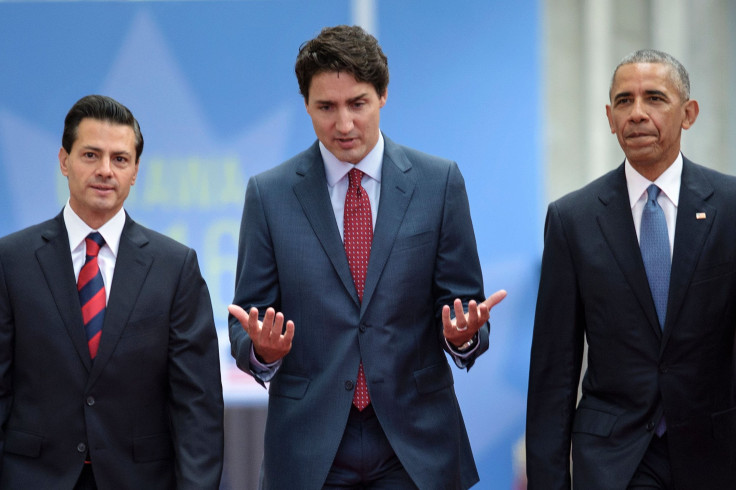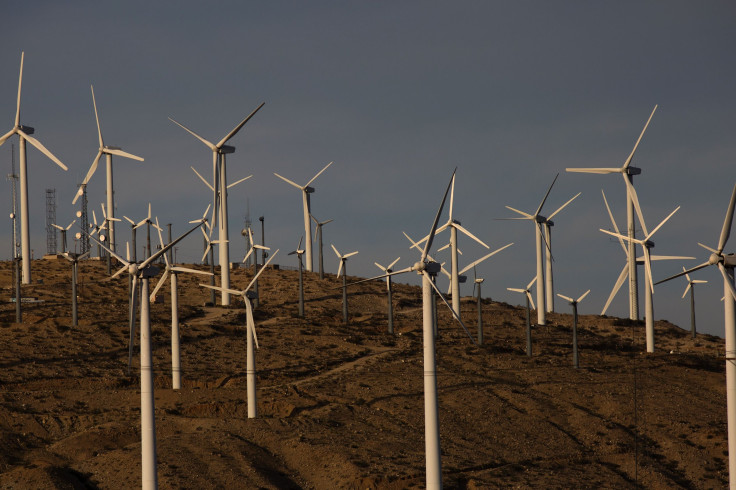Three Amigos Summit 2016: 5 Ways To Achieve The North American Clean Energy Agreement

The leaders of the United States, Canada and Mexico pledged Wednesday to generate half of North America’s electricity from zero-carbon sources within the next 10 years.
U.S. President Barack Obama, Canadian Prime Minister Justin Trudeau and Mexican President Enrique Peña Nieto — the trio at the so-called Three Amigos summit in Ottawa, Canada — said they would work to build more wind, solar, hydroelectric and nuclear power in their backyards, and develop carbon capture and storage projects and other energy-efficiency measures.
Zero-carbon sources today account for about 37 percent of the region’s electricity mix. To raise that to 50 percent by 2025, the three nations will need to invest billions of dollars in new power projects and adopt generous incentive programs and regional trade policies to spur greater energy development, energy experts said. “It’s a big push,” Sam Adams, director of the World Resources Institute’s U.S. Climate Initiative and a former mayor of Portland, Oregon, said by phone from Ottawa. “But we think it’s a realistic goal.” Here are five things that need to happen to make the plan a reality:
1. The U.S. will have to pull most of the region’s weight.
The U.S. power market is about 10 times the size of Mexico’s and just over six times the size of Canada’s, in terms of annual power generation. Thus much of the burden will fall on the 50 U.S. states, said Colleen Regan, the head of North American cross-sector research and environment markets at Bloomberg New Energy Finance in New York.
Canada produces 81 percent of its electricity from hydropower plus smaller levels of nuclear, wind and solar, and the nation is already on track to hit 84 percent zero-carbon energy by 2025, Regan said. Mexico gets just 22 percent of its power from cleaner sources, although it is slowly developing more wind and solar power. Because Mexico’s grid is relatively small, however, those renewables projects will green the local grid, but they won’t do much to boost the regional total.
About a third of U.S. power comes from zero-carbon sources. Nuclear supplied 20 percent and hydropower supplied 6 percent of total U.S. electricity generation in 2015. Renewables, including wind and solar, accounted for 7 percent of last year’s total, according to the U.S. Energy Information Administration.
2. The U.S. will need to deploy more wind and solar power.

Compared to massive, multibillion-dollar nuclear and hydropower plants, renewables projects are relatively easier to build, Regan said. Smaller installations sprawled across the country can come online faster than hulking projects since securing financing, ironing out logistics and securing permits is less cumbersome.
Wind and solar also have more political and popular support. Congress in December opted to extend two key federal tax incentives — the Production Tax Credit for wind projects and the Investment Tax Credit for solar projects — which proponents say will fuel a surge in new renewables installations over the next five years.
3. U.S., Canada and Mexico must build a ‘clean energy’ Keystone XL pipeline.

Building large transmission lines to spread zero-carbon power supplies across North America is a critical step to hitting the 50 percent target, said Paul Bledsoe, a former climate adviser to President Bill Clinton who now consults on climate policy in Washington.
In places such as Texas, the Mexican desert, or northern Canada, the best supplies of wind, solar or hydro power are often hundreds of miles away from densely populated cities where most of the electricity is consumed. Major transmission lines can cost billions of dollars and take years to site and build. But connecting supplies to demand centers can also help drive down energy prices and encourage development of renewables.
Bledsoe likened such transmission projects to the Keystone XL, the controversial pipeline that would have carried high-carbon western Canadian crude to U.S. Gulf Coast refineries. Critics worried the project, which Obama finally killed in November, would have spurred greater oil sands production by bringing supplies to wider markets. In that sense, transmission lines “are the clean-energy analogue to the Keystone pipeline,” he said.
4. The three nations must consider carbon capture and storage.

CCS technology involves removing carbon dioxide from the exhaust steam of coal or natural gas-fired power plants. The emissions can then be pumped deep underground or used in industrial applications, such as making fertilizer or producing new electricity. Proponents say capturing carbon will be necessary for the world to both continue burning fossil fuels and reach an international goal to limit global warming to well below 2 degrees Celsius (3.6 degrees Fahrenheit) above pre-industrial levels, which scientists say must be done to avert planetary disaster.
So far, however, efforts to develop CCS have mostly stumbled. The only large-scale, operating CCS facility in North America is Canada’s $1.4 billion Boundary Dam facility. The project was formally commissioned in the fall of 2014, but it’s captured far less carbon than initially expected and encountered operational problems. In the U.S., a long-awaited project by Southern Co. in Kemper County, Mississippi, has faced numerous delays and billions of dollars in cost overruns.
Bledsoe said CCS facilities could help North American nations meet their joint clean energy target, but only if governments roll out tax breaks and other incentives to cut developers’ costs.
5. It’s up to the next U.S. president to formalize the plan.

The 50 percent zero-carbon target isn’t a binding treaty or regulation. And in the U.S., it will be up to Obama’s successor to formalize the plan next year. The next president could seal the goal with an executive order, said Stephen Munro, a U.S. policy analyst at Bloomberg New Energy Finance in Washington.
Hillary Clinton, the presumptive Democratic nominee, “is clearly simpatico with these goals,” Bledsoe said. Donald Trump, the likely Republican candidate, has vowed to increase fossil fuel production and cancel existing U.S. commitments to reduce greenhouse gas emissions. The real estate mogul has staunchly denied that humans are contributing to global warming, calling the phenomenon an “expensive hoax.”
However the 2016 presidential race pans out, Bledsoe said, “The imperative to reduce emissions is not going away, no matter who is elected.”
© Copyright IBTimes 2024. All rights reserved.





















